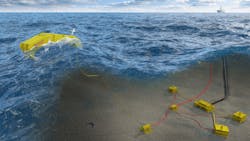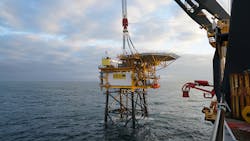Leading UK North Sea independent Chrysaor is supporting a project examining new ways of powering subsea tiebacks and resident autonomous underwater vehicles (AUVs). The program is assessing the potential of Mocean Energy’s Blue Star wave energy converter and EC-OG’s HALO subsea energy storage system. Both companies are co-funding the development along with AUV specialist Modus; and the project has further backing from the Oil and Gas Technology Centre in Aberdeen and Wave Energy Scotland, which has agreed to supply Mocean with $4.3 million to construct and test a half-scale version of its technology later this year at a location offshore Orkney, northern Scotland. Once Blue Star and HALO are proven, they could theoretically provide back-up power in the event of an umbilical line failure, as well as charging future fleets of AUVs.
Although oil and gas remains the dominant market for northwest Europe’s subsea supply chain, offshore wind continues on its steep growth trajectory. Mhairidh Evans, principal analyst, Upstream Supply Chain at Wood Mackenzie, told delegates at the recent Subsea Expo conference in Aberdeen that nearly 30% of new subsea wells sanctioned worldwide during 2018-19 were in Norwegian and UK waters. However, although demand recovered in this period, the year ahead will likely be “flat”, she warned, as oil and gas operators continue to rein in spending. The outlook for subsea is uncertain, she added, with no guarantees of a new oil and gas cycle ahead. Spending on offshore wind, however, looks set to double between now and 2025 to reach $49 billion/yr, Evans predicted, with much of the investments in Europe.
Aker BP trialling robot inspectors
Aker BP has agreed to collaborate with AI software developer Cognite on trials of various robots and drones this year on the Skarv FPSO in the Norwegian Sea, to assess their capabilities in autonomous inspection, data capture and report generation. Tasks may include aerial and underwater inspections, leak response, and work in difficult-to-access hazardous areas. Equipment to be trialled will include Boston Dynamics’ Spot quadruped robot.
Under a planned trade-out with Poland’s PGNiG Upstream Norway, Aker BP will assume operatorship of the latter’s recent Shrek discovery in Norwegian Sea license PL838. This should facilitate a development via a subsea tieback to Skarv. In the North Sea, the company has turned its attention to a development of the Hanz accumulation via spare capacity on the Ivar Aasen platform. Farther south, the company has settled on a normally unattended wellhead platform as its preferred concept for the proposed redevelopment of the chalk Hod oilfield. This follows good experience with a similar 12-slot installation which entered service late last year at the nearby Valhall Flank West.
Also in the North Sea, a new gas module has rolled into action on Equinor’s Troll C platform following a NOK1-billion ($108-million) investment. The project, launched in 2017, was designed to increase gas processing capacity on the platform by 3.5 MMcm/d to boost production from the satellite Fram oil and gas field, 20 km (12.4 mi) north of Troll, and to facilitate tie-ins of discoveries on the Fram license such as last year’s Echino South discovery. Aibel constructed the new 400-metric ton (441-ton) module in Haugesund.
Topsides re-used for Sillimanite gas project
Wintershall Noordzee, a joint venture between Wintershall Dea and Gazprom EP International, has started gas production from the Sillimanite field on the UK/Dutch median line in the southern North Sea, around 200 km (124 mi) from the coast of Den Helder. For the second time the company recycled the topsides originally built for the P14-A platform in the Dutch sector, which it had subsequently reconditioned for the E18-A platform (now decommissioned). The latest development took 16 months to complete from project sanction. Wintershall Noordzee now plans to tuun its attentions to the Rembrandt/Vermeer oilfield developments in the Dutch sector. Vermeer will feature an integrated wellhead, process, utility and living quarters platform over a subsea storage tank, offloading production to shuttle tankers, while Rembrandt will produce through a normally unmanned wellhead platform.
Providence seeking backers for Barryroe wells
Providence Resources has re-started the process of seeking farm-in partners to the Barryroe oil and gas field project in the Celtic Sea off southern Ireland, after China’s APEC failed to deliver the required finance having taken 50% equity in the surrounding license. Assuming APEC complies, Providence subsidiary Exola and Lansdowne Celtic Sea would revert to their original 80% and 20% interests.
Providence believes Barryroe contains a mid-case resource of 346 MMboe in Middle/Basal Wealden sands, but wants to drill at least two more appraisal wells and to conduct an extended test to confirm whether this is a large oil field with an overlying gas cap of a large gas field with an oil rim. •
About the Author
Jeremy Beckman
Editor, Europe
Jeremy Beckman has been Editor Europe, Offshore since 1992. Prior to joining Offshore he was a freelance journalist for eight years, working for a variety of electronics, computing and scientific journals in the UK. He regularly writes news columns on trends and events both in the NW Europe offshore region and globally. He also writes features on developments and technology in exploration and production.


